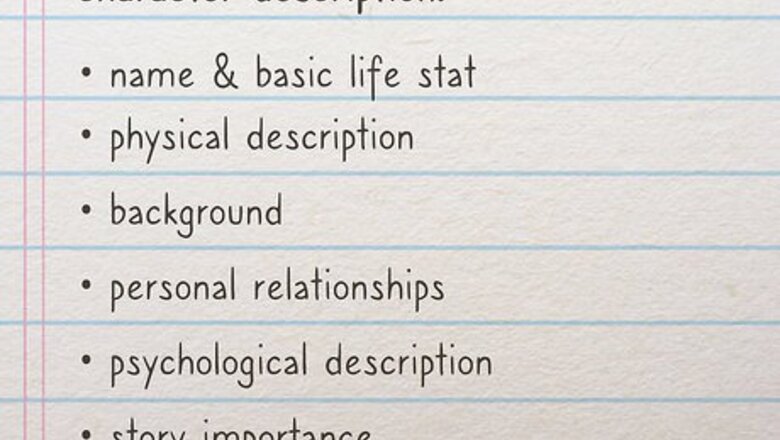
views
X
Expert Source
Lucy V. HayProfessional Writer
Expert Interview. 16 July 2019.
With all of this figured out, you can write characters that seem like real people for your readers.
Envisioning the Character’s Appearance
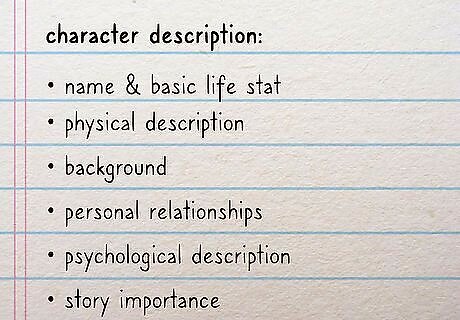
Start with a simple sentence describing the character. Many writers start off with a very short description of a character before doing a full profile. This quick description usually describes a distinguishing feature and sets the tone for the character’s role in the story. Before planning a character completely, imagine how you might introduce that character into the story and what you'd want the audience to know about them. Write this out in a short sentence to get started. When you get the introduction down, use all of the details you provided to build more background and personality for the character. You might introduce a character as “tired and looking much older than he really is.” This is a great starting point because it gives you plenty to dive into for the character’s background. Think about why they look older than they really are and what struggles have they faced that wore them down.
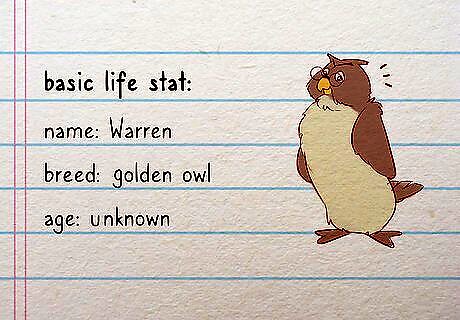
Write down the character’s basic life statistics. This is general information about the character that helps you create a more detailed profile of their personality. Basic information includes age, birthday, current residence, and job. Then use this basic information to get more specific. If you decided on a job for the character, think about their income. What social class does this put them in? You don’t have to fill in every single aspect of the character’s life. This is more of an exercise to get your creativity working and put you inside the mind of the character you’re planning.
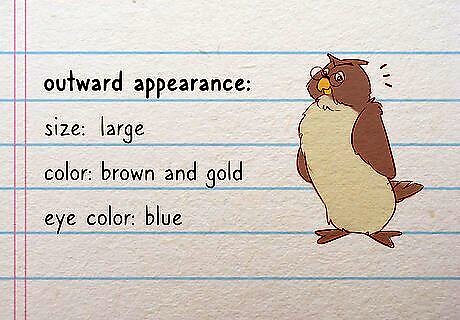
Envision the character’s outward appearance. Physical descriptions are important for main characters. You may have already had an appearance in mind for your character before you started writing the profile, or you may have to develop one. In either case, write down your plan for the character’s appearance and how you’ll describe it in the story. Think about what the character’s appearance means for their personality as you move further. Start with very basic information like hair and eye color and clothes the character normally wears. Does the character have a beard or not? Is their hair color natural or dyed? Then get more detailed about the appearance. Decide if the character usually well-groomed or slightly unkempt. Think about what a well-groomed person could be hiding, or what a messy person might be struggling with. Also determine if the character has any distinguishing marks or features. A scar on someone’s face, for example, can tell a whole story about a character and how they received that injury.
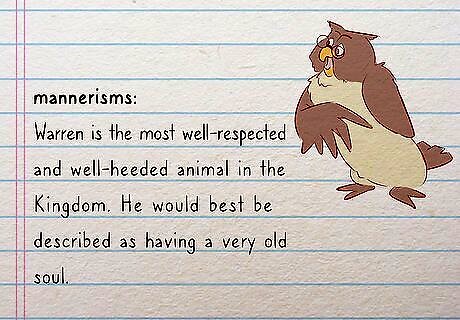
Develop mannerisms for the character. Once the physical description is out of the way, get deeper into the character’s profile by imagining how they would act in everyday life. Developing mannerisms like speech patterns help you truly visualize a character, and also help your audience connect with that character more. Think about how your character walks into a room. Decide if they are the type of person who would walk in confidently and introduce themselves to everyone there, or sneak in so no one sees and stay out of sight. Envision the character's speech pattern. Do they have an accent? Do they use a lot of big words to try and sound smart? Do they have a stutter? Plan out if the character has any other ticks or habits. Perhaps they tend to blink a lot if they lie. This could be a plot point in the story later on.
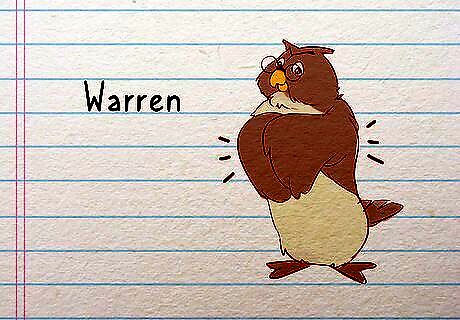
Name your character. Depending on your preferences, the character’s name could be very important or secondary. If you like putting a lot of symbolism in names, then spend some time thinking about what you’d like this character’s name to stand for. Otherwise, focus more on the character description and pick a name that comes to you. Unless there is symbolic meaning for the character’s name, don’t stress too much about coming up with a great name. Focus more on description so your readers connect with the character. If you don’t care much about the character’s name, there are random name generator tools online that will help. One thing that is very important is keeping different character names distinct from each other. For example, having a John, Jack, and Joe will get confusing for readers. John, Armando, and Scott are much more distinctive names. Think about any nicknames the character has as well, and in what situations characters use different names. For example, if everyone calls a character Joe but during an argument his wife calls him Joseph, that could automatically tell the audience that she’s angry with him.
Developing the Character’s Background
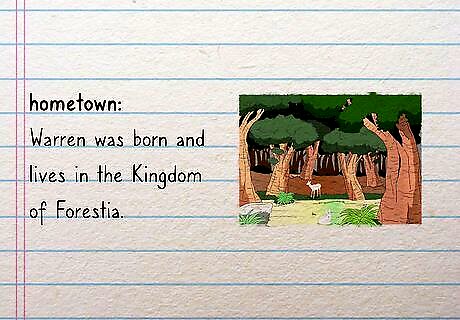
Decide on a hometown for the character. If the character isn’t living in their hometown in the story, plan where the character came from. If the story takes place in New York but the character was born in Atlanta, explain what the character is doing in New York. Plan the rest of the profile using this information. Establish how long the character lived in their hometown and if they lived there long enough to have the local accent. Think about why the character left their hometown. Did they just move for work, or did they not get along with their family? Does the character miss their hometown, or were they happy to leave?
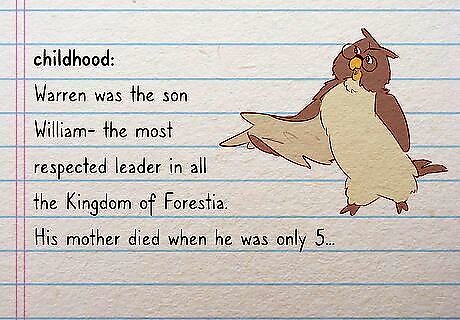
Plan the character’s childhood. The background of a character is usually very important for their overall personality. If the character is an adult, think about what their childhood would have been like. Use this information to determine if that character would view their life as successful or not. Develop as many details as you can about the character’s childhood. Try to come up with their best friend, school, favorite teacher, hobbies, career goals, and favorite foods. Outline any trauma the character suffered as a child. Perhaps this why they left their hometown, or why they have trouble forming friendships later on. Maybe the character was spoiled as a child and never had to struggle. This is also important for their personality.

Map out the character’s personal relationships. How the character interacts with other people is crucial for their role in the story. Decide if they are kind and caring, or manipulative. Figuring out how the character treats other characters helps you plan the rest of the character arc. Start simple with the character’s personal relationships. List their parents, siblings, and other close family members. Decide if the character is married or single. Then think more deeply about what these personal relationships mean. Choose who the character would talk to if they needed help, or who they would ask for money if they were struggling. Does this character make a lot of friends easily, or do they just have a lot of acquaintances? If the latter, explain why they have trouble connecting with people.
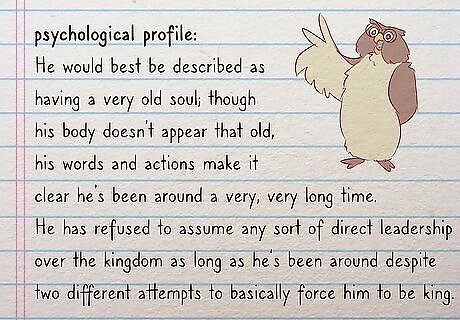
Build the character’s psychological profile. With the physical and personal descriptions out of the way, get deeper into the character’s psyche. Develop hopes, dreams, fears, likes, and dislikes for the character. Think about how this psychological profile influences the way they act throughout the story. Ask a broad question like, “Is this character happy?” If they are, consider if something in the story will ruin their happiness. Or if they start off unhappy, decide what happened in their past that prevents them from feeling happy. Then work more into how your character reacts to the world and what makes them angry and sad. Would your character consider themselves accomplished, or would they say they are a failure?
Defining the Character’s Role in the Story
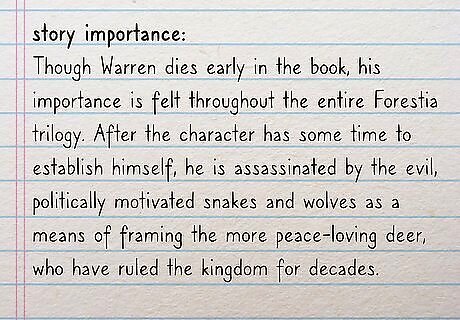
Decide if this character will experience a life-changing event in the story. This is important because it determines if the character will change or remain the same throughout the story. They may experience a fundamental personality change between the beginning and end of the story. If this happens, plan the event that caused the character’s transformation. What lessons did they learn or fail to learn? Think about if the character will experience a life-changing event but doesn’t change. For example, experiencing the death of one’s spouse would be a life-changing event for most people, but if your character is unaffected by this, explain why that is.

Plan if this character will be a protagonist or antagonist. A protagonist is a “good guy” and an antagonist is a “bad guy.” With your character details figured out, define which of your characters falls into each category. This way, you build up the cast for your story. Keep in mind that not all main characters are protagonists. You could flip the perspective by making your main character the antagonist who causes everyone else’s struggles in the story.
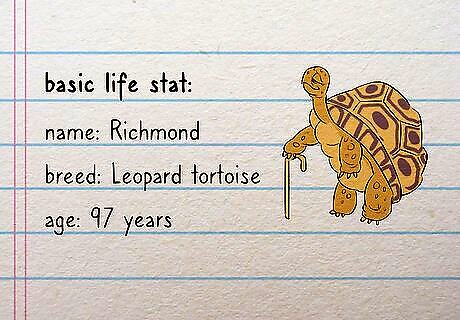
Write another profile if the character will age in the story. People change as they get older. The beliefs they held can change over time. Think about the timescale of your story. If it covers years, then some of your characters could change significantly in that time. In this case, build new character profiles for each character at different ages. This helps you work out how the character changes through time. If the change is only a few months, then new profiles aren’t necessary unless a character changes completely in that time. Take the character’s relative age into account to decide if they need a new character profile. For example, if the character was 10 in one chapter but 15 in another, that’s a big jump. However, if someone goes from 30 to 35, that’s not as big of a jump because a 30-year-old has already established their personality.




















Comments
0 comment